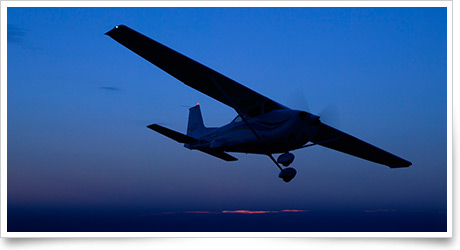| The following stories from the Jan. 13, 2012, edition of AOPA ePilot were provided to AOPA members who expressed an interest in the particular subject areas. Any AOPA member can receive information tailored to their areas of interest by updating their preferences online. |
training tipsWinter nights Now is the time of year to nail down those requirements for the private pilot certificate. Under the regulations you must have three hours of night flight training in a single-engine airplane that includes one cross-country flight of more than 100 nautical miles total distance, and "10 takeoffs and 10 landings to a full stop (with each landing involving a flight in the traffic pattern) at an airport" to be eligible for night-flying privileges. The Air Safety Institute’s Night Flying Safety Spotlight will help you to review some special considerations for planning and executing a night flight. Three hours will give you a taste of night flight, but hardly a complete survey. So it’s not automatically a good idea to log all the required night training in one long evening session. Dividing it into multiple missions broadens your experience, and avoids fatigue. Launching on the initial night flight at dusk and continuing under moonlight is an ideal introduction. Next time, move on to darker skies and more challenging surface winds. This lesson plan offers night-flight preparation pointers. As for that 100-nm cross-country flight: Select a route by giving possible destinations careful review. Note what kind of lighting exists at planned stops. Research how to operate any pilot-controlled lighting system. If you selected a towered airport, check hours of tower operation. If the tower is closed when you arrive, what airspace class will be in effect? Build a strong margin of obstacle clearance into your selection of a cruise altitude, with forecast cloud levels also to be considered. Keep night fuel-reserve requirements in mind when calculating your requirements. Will you overfly or pass near other airports en route? That's good insurance in the event of an emergency. Expect to rely much more on your attitude-control instruments under night VFR conditions. Keep a running check on weather—ahead and behind—paying attention to any narrowing temperature/dew-point spread. That spread is your early warning about formation of fog. Certain optical illusions are characteristic of night flight. Also, crosswinds may seem more pronounced with fewer visual references by which to judge their intensity. Practicing those 10 (or more) takeoffs and landings will be exhilarating—and light traffic may give you more options. Your instructor may have you land once or twice without your landing light—good experience—and landing lights do sometimes fail. Enjoy the beauty of night flight, while moving your training forward. training products‘Then and Now: How airplanes got this way’ by Phil ScottLongtime AOPA Pilot and Flight Training contributor Phil Scott has published a collection of historical essays that take a lighthearted look at aircraft through history. He explains why an airplane can stall with its engine running at full speed; who invented rudder pedals, ailerons, and the fuselage; and much more. Sporty's is taking advance orders for the book, which will sell for $19.95. Order online or call 800/776-7897 (800/SPORTYS).
Note: Products listed have not been evaluated by ePilot editors unless otherwise noted. AOPA assumes no responsibility for products or services listed or for claims or actions by manufacturers or vendors. final examQuestion: How soon after passing the practical test for the private pilot certificate may I exercise the privileges of that certificate?
Answer: You may do so immediately. After passing the practical test, the designated pilot examiner will issue you a temporary airman certificate. This certificate allows you to exercise the privileges of your private pilot certificate with the appropriate ratings and/or limitations. The temporary certificate is an interim one, subject to the approval of the FAA pending the issuance of your permanent certificate. You should receive your permanent certificate within 120 days.
Got a question for our technical services staff? E-mail [email protected] or call the Pilot Information Center, 800/872-2672. Don’t forget the online archive of “Final Exam” questions and answers, searchable by keyword or topic. |
 Got your night flying done yet?
Got your night flying done yet?

